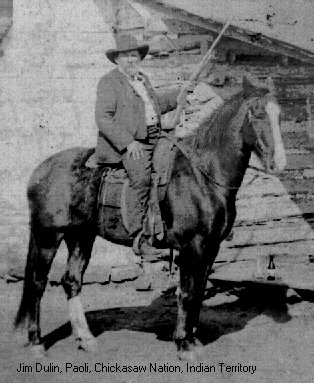

| |||
James Dulin
Private, Company F,
34th Texas Calvary
By
4985 Seibert Ave.
St. Louis, MO 63123

James Dulin was born in Henry County, Georgia on July 5, 1837. His father was Sugar Dulin and his mother was Tabitha Howard. James was the grandson of the first Sugar Dulin who lived in North Carolina and was a Revolutionary War veteran. James was an only son. His mother died when he was quite young and he was sent to live with his maternal grandparents. They both died a few years later and he went to live with one of his uncles.
When he was seventeen his uncle offered to send him to school, instead he joined a wagon train bound for Texas. He had no money and worked his way eventually to Rush County. After a short time he went with the Hittson family to Crow Creek country in Hill County. In 1856 James and his friends the Hittson's moved to Grindstone Creek in Parker County. After assisting in the organization of Parker County, James moved to Palo Pinto County. He then moved to Hubbard Creek in what is now Callahan County.
In 1859, James and six others under the leadership of Joel McKee left Texas for the gold mines of Colorado. He was not successful at this venture and went to New Mexico. After working through the winter cutting saw logs, he returned to Colorado the next spring, locating in California Gulch.
Again unsuccessful, James returned to Texas in the fall of 1860. He stayed a short while in Hopkins County and then returned to Palo Pinto County. The Comanches were causing a lot of trouble during this period and a few weeks after his return James joined a party led by Sul Ross to follow and punish the Indians. He was with this party at the Pease River Fight where Cynthia Ann Parker (mother of Quannah Parker) was recovered after twenty years of captivity. After this campaign James engaged in the cattle business and went with a herd from Calahan County to the mouth of the Red River in Louisiana.
In February 1862 James enlisted in Company F (Alexander’s Regiment) of the 34th Texas Cavalry under David B. Cleveland in Palo Pinto County. On the company muster roll records James is listed as "absent, on detached service. Due for use of arms $10.50 to Dec. 17, 1862, for mileage for 180 miles" and "Detailed November 4th, 1862, to herd beeves left at Camp Kiamishi (sic)."
After the war James took up the stock business as a regular occupation. In 1867 he took a herd to Missouri for Colonel Jim Childs and shortly thereafter drove a herd to Shreveport for Cummings and Vinnette. He next made a drive to Abilene, Kansas for Jim Scoby. When he returned to Sherman he was put in charge of a wagon train hauling freight between points along the Red River and Fort Smith, Arkansas. He continued in this business for three years at which time he moved to Indian Territory.
James Dulin married first in 1864 in Texas to Janie Moore. They had one son named George Dulin.
In 1871 James married Pocahontas Walner in Indian Territory. She was born in Indian Territory and died 17 Apr 1879, in the Chickasaw Nation, Pontotoc, Co. (now Paoli, Garvin Co., the Chickasaw Nation was divided into counties), Oklahoma, and was buried in the Dulin Family Cemetery in Paoli, Garvin Co., Oklahoma. They had two children: Susie and Simpson Dulin (my grandfather). Pocahontas was a member of the Chickasaw Nation and the daughter of a famous physican, William Walner, for whom the author of this article is named. Dr. Walner had long been a doctor for the Chicksaws. Her mother was Susan Carter, a Chickasaw. By this marriage to Pocahontas, James acquired the rights of Chickasaw citizenship. He and his wife settled on the Blue River twelve miles west of Caddo, Indian Territory. They lived there until the spring of 1878 at which time they moved to what would become the townsite of Paoli, Oklahoma. While at Blue River two children were born to them, Susie and Simpson. On April 17, 1879 Pocahontas died while in childbirth. The child was stillborn.
James married a third time in September 1879 to Lizzie Bergin. She was living in Norman, Oklahoma Territory when James died and I have been told she was buried in Norman, Cleveland Co., Oklahoma. James and Lizzie Dulin had two children: Fanny and Lizzie Dulin.
In 1886 the Sante Fe Railroad built its road bed through his property and the town of Paoli was established there.
James Dulin died of pneumonia on November 6, 1895. He is buried in the Dulin Family Cemetery along with his wife, Pocahontas, his father-in-law, William Walner and the stillborn child. The cemetery is located within the city limits of Paoli, Garvin Co., Oklahoma. At the time of his death he owned some 4 miles square (10,000 acres) of Washita Valley land. The foundation of his house still remains. He was a member of the Caddo Masonic lodge and later a member of the Pauls Valley Masonic lodge. The author of this article is his great-grandson.
Sources
1. Historical and Biographical Record of The Cattle Industry and The Cattlemen of Texas and Adjacent Territory, Woodward & Tiernan Publishing Co., St. Louis, Missouri, 1895.
2. Leaders and Leading Men of the Indian Territory, Harry F. O'Beirne, Chicago, 1891.
3. Indian Pioneer History.
4. The personal knowledge of the author.
©Ron Brothers and William W. Dulin, All Rights Reserved, 1999.